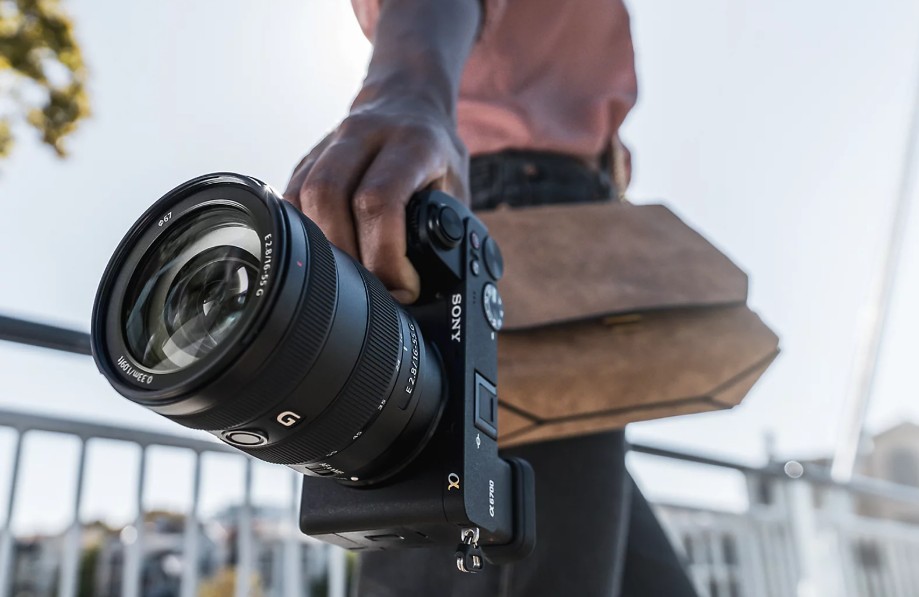Best Selling Products
Explore the World of Birds Through the Lens of Art at the 2025 Audubon Photography Awards
Nội dung
- 1. Grand Prize: Felipe Esteban Toledo Alarcón
- 2. Grand Prize: Liron Gertsman
- 3. Birds in the Landscape: Joe Subolefsky
- 4. Birds in the Landscape, Colombia: Shamir Shah
- 5. Birds in the Landscape, Chile: Caro Aravena Costa
- 6. Birds Without Borders: Jacobo Giraldo Trejos
- 7. Birds Without Borders: Yoshiki Nakamura
- 8. Conservation: Luis Alberto Peña
- 9. Conservation: Jean Hall
- 10. Plants for Birds: Barbara Swanson
- 11. Tree for Birds, Colombia: Cristian Valencia
- 12. Tuổi trẻ: Camilo Sanabria Grajales
- 13. Youth: Parham Pourahmad
- 14. Coastal Birds, Chile: Francisco Castro Escobar
- 15. Female Award: Sean Pursley
The 2025 Audubon Photography Awards is not only a celebration of outstanding photographic work, but also a powerful reminder of the relationship between humans and nature.
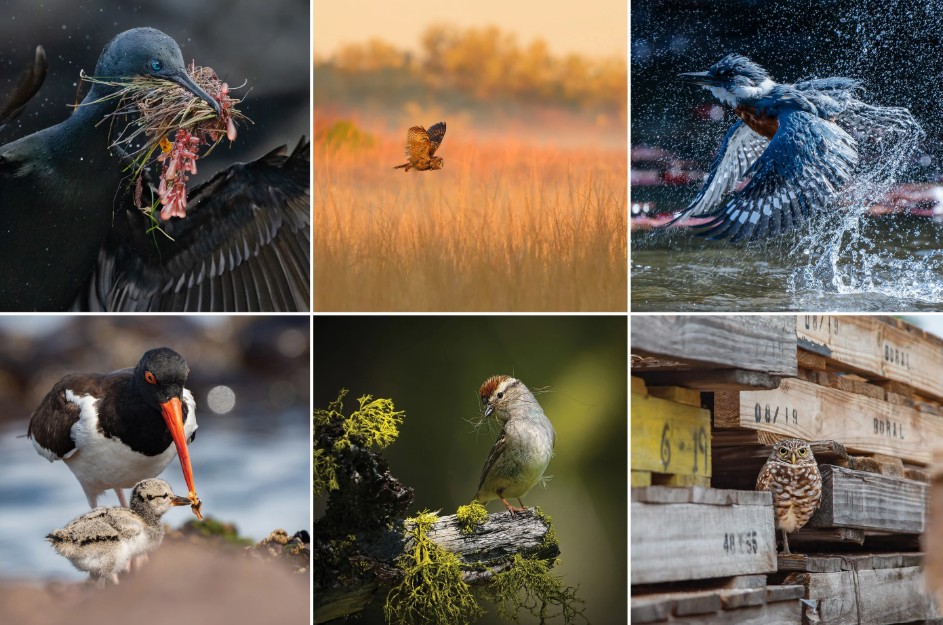
Among the world's most prestigious nature photography awards, the Audubon Photography Awards always holds a special position. Organized annually by the Audubon Society, a famous non-profit organization in the field of bird and habitat conservation. This competition not only honors beauty, but also conveys a profound message about human responsibility towards the blue planet.
In 2025, the Audubon Photography Awards continued to leave a strong impression with thousands of entries from around the world. The winning photos not only touched the hearts of viewers with their visual beauty, but also evoked reflections on the connection between humans and nature. In this article, let SaDesign explore in detail the outstanding works in 15 award categories in 2025.
1. Grand Prize: Felipe Esteban Toledo Alarcón
- Competition: Chile and Colombia
- Species: Ring-necked Kingfisher
- Photo location: Valdivia, Los Ríos, Chile
- Camera: Sony Alpha 7 IV with Sony FE 200-600mm f/5.6-6.3 G OSS lens at 600mm; 1/3200 sec at f/6.3; ISO 2500
The largest of the six species of kingfisher in the Americas, the ringed kingfisher ranges from Texas to southern South America. In tropical regions where four or five species may appear together, these birds avoid competition by pursuing different prey from different heights. The smallest may perch just a few inches above the water, searching for small fish or insects. The ringed kingfisher may perch as high as 30 feet above the water, searching for medium-sized fish, then dive headfirst into the water with a powerful splash.
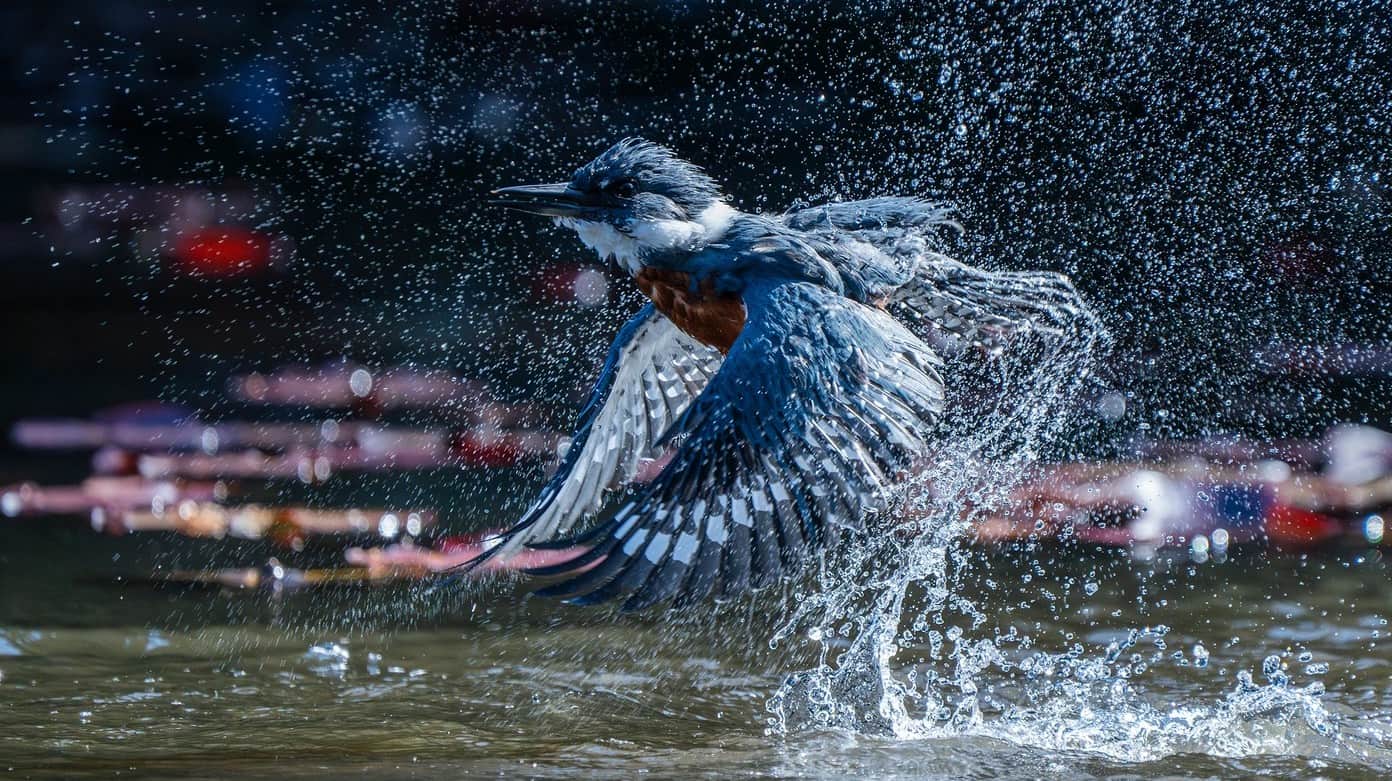
2. Grand Prize: Liron Gertsman
Nearly two dozen birds flew across the deep blue sky. Their long, narrow wings and forked tails stood out against the thin clouds and the sun, surrounded by a brilliant halo.
- Competition: United States and Canada
- Species: Frigatebird
- Photo location: Teacapán, Sinaloa, Mexico
- Camera: Canon EOS R5 with Sigma 14mm f/1.8 DG HSM Art lens (for Canon EF lenses) and Canon EF-EOS R Mount Adapter; 1/2500 sec at f/16; ISO 160
It may sound like a cruel joke of evolution, but frigates are true seabirds, meant to avoid landing in the sea. An individual that lands in the water can have trouble getting back up, and if its feathers get wet, it can drown. So frigates fly over the sea for days or weeks in search of food. They are well equipped for the task: a frigate’s feathers weigh twice as much as its skeleton.
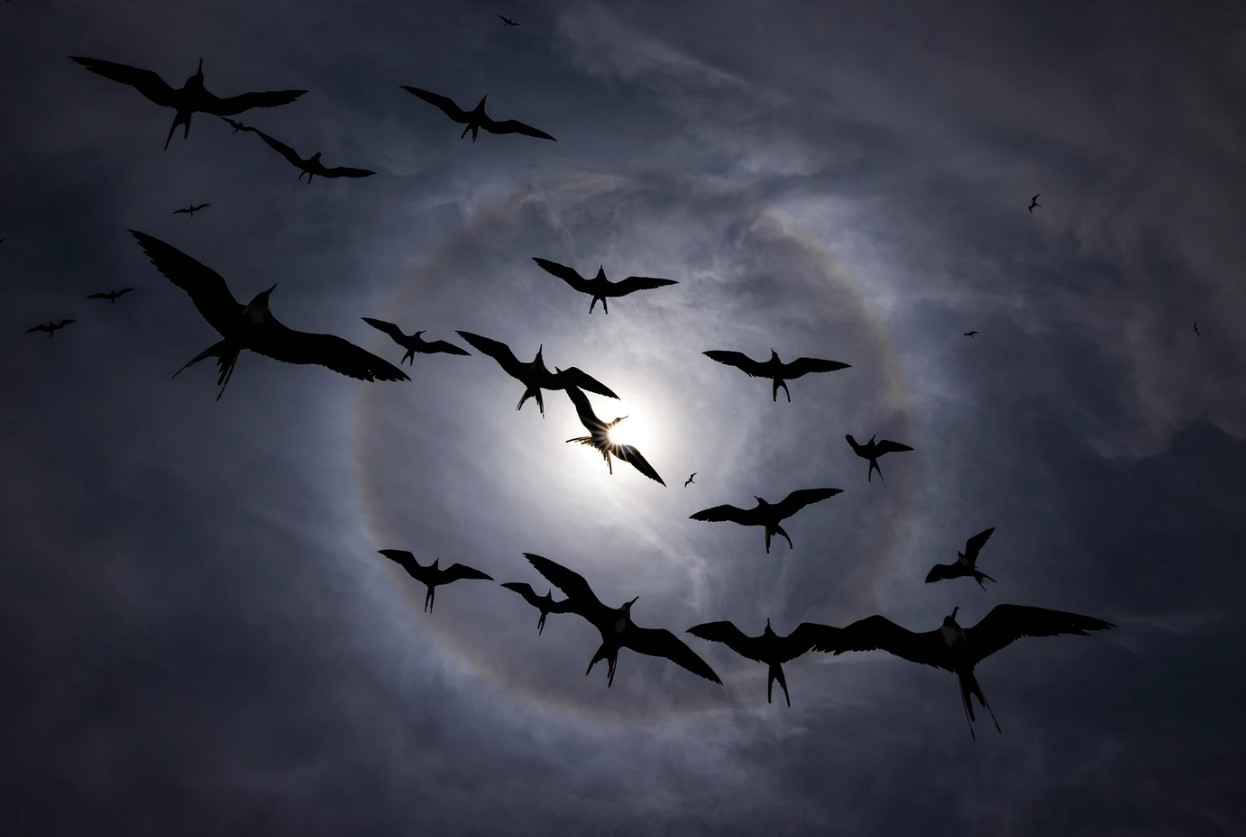
3. Birds in the Landscape: Joe Subolefsky
Thousands of white booby birds dot a dark rock in the foreground. A vast bay, a starry night sky, and a faint Milky Way illuminate the background.
- Competition: United States and Canada
- Species: Northern booby
- Photo location: Cape St. Mary Ecological Reserve, Newfoundland and Labrador, Canada
- Camera: Canon EOS R5 with Canon RF 15-35mm f/2.8L IS USM lens at 15mm; 20 seconds; ISO 6400
Most true seabirds nest in colonies, not single pairs. The reason is obvious: There’s a vast ocean out there, with countless feeding grounds, but few nesting sites. The northern booby is distributed throughout the North Atlantic and beyond, but nests in only about three dozen locations. These colonies, on steep rocky islands or sometimes coastal cliffs, can number in the tens of thousands of pairs.
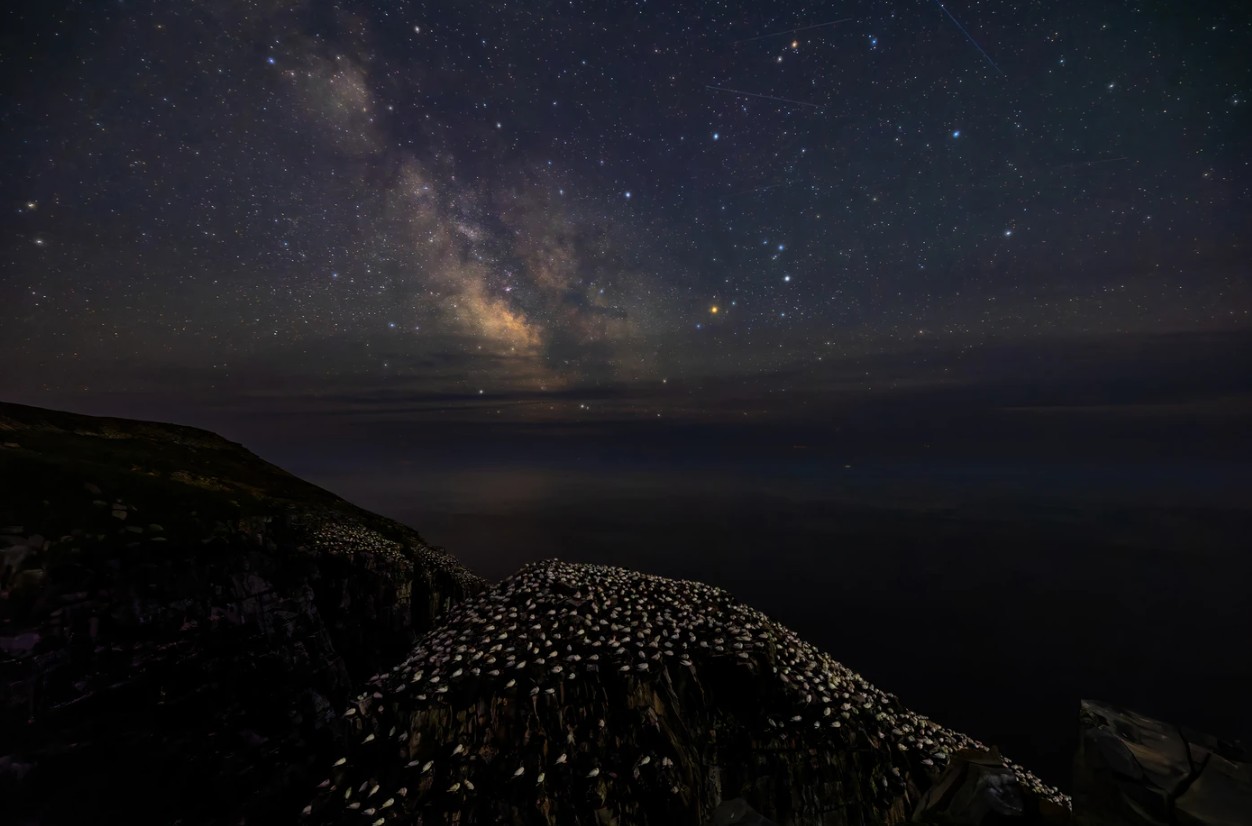
4. Birds in the Landscape, Colombia: Shamir Shah
The green heads of two parrots protrude from a hole in a curved branch. Below, in a blur, cars, motorbikes and buses pass by on a busy street.
- Competition: Chile and Colombia
- Species: Green-headed parrot
- Photo location: Santiago de Cali, Valle del Cauca, Colombia
- Camera: Nikon D750 with AF-S NIKKOR 24-120mm f/4G ED VR lens at 120mm; 1/60 second at f/4; ISO 250
Among the most common and widespread parrots in northern South America, pairs or flocks of green-crowned parrots fly with rapid, deep wingbeats and high-pitched calls at treetop height. They seem to be better adapted than many other parrots and can even live on the fringes of cities, provided each pair can find a tree cavity large enough to nest.
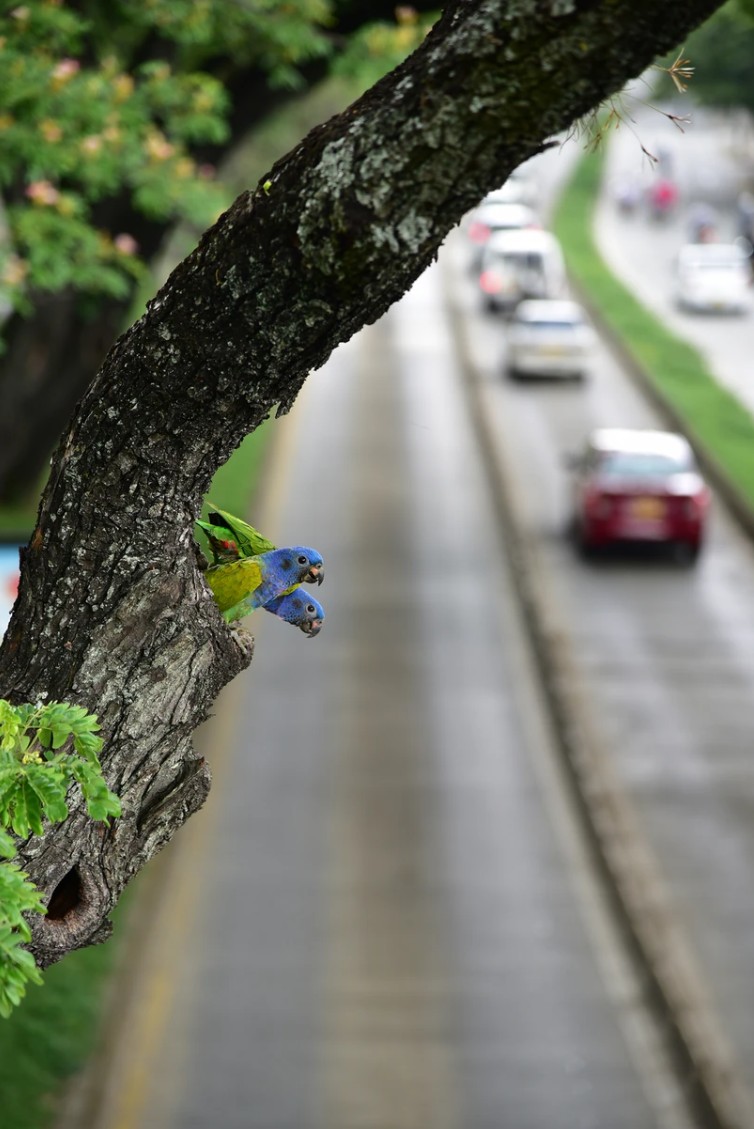
5. Birds in the Landscape, Chile: Caro Aravena Costa
About 25 flamingos stand in the shallow water on the beach. Their bodies are backlit, creating shadows. A low, flat layer of clouds and towering mountain silhouettes form the background. Warm sunlight bathes the scene.
- Competition: Chile and Colombia
- Species: Chilean Flamingo
- Photo location: Puerto Natales, Magallanes and Antarctica, Chile
- Camera: Sony Alpha 7 IV with Sony FE 100-400mm f/4.5-5.6 GM OSS lens; 1/1000 sec at f/16; ISO 64
Many people think of flamingos as tropical birds, but there are actually three South American species that live in cold climates. All are found on the Altiplano, the plateau between the highest ranges of the southern Andes, where they use their strange bills to sift tiny crustaceans, insects, and diatoms from shallow saltwater lakes. The most common of the three, the Chilean flamingo, also lives at sea level, all the way to the frigid southern reaches of the continent.
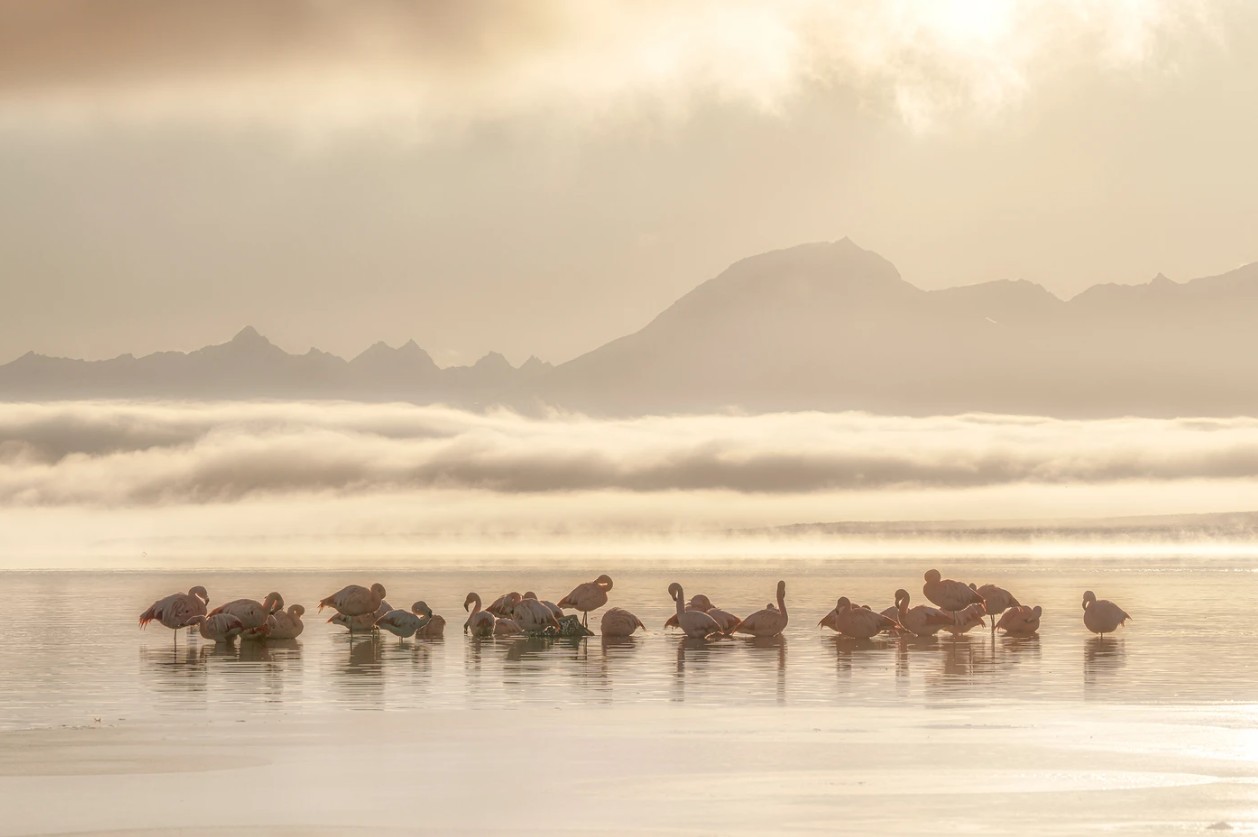
6. Birds Without Borders: Jacobo Giraldo Trejos
A grey-white bird, hovering in the air with its wings spread out, was feeding a baby bird perched on the railing, using its orange beak to give it a fish.
- Competition: Chile and Colombia
- Species: Royal Tern
- Photo location: San Andrés Island, San Andrés and Providencia, Colombia
- Camera: Canon EOS R50 with Sigma 150-600mm f/5.6-6.3 DG OS HSM Contemporary lens at 562mm; 1/3200 sec at f/8; ISO 800
While most songbirds are independent within a few weeks of leaving the nest, the Royal Swallow has a relatively long maturation period. Parents may feed their young for up to eight months, even as the entire family migrates together, some from the eastern United States as far as the Pacific coast of South America. So a Royal Swallow chick begging for winter food may have hatched nearby—or may have flown thousands of miles north.
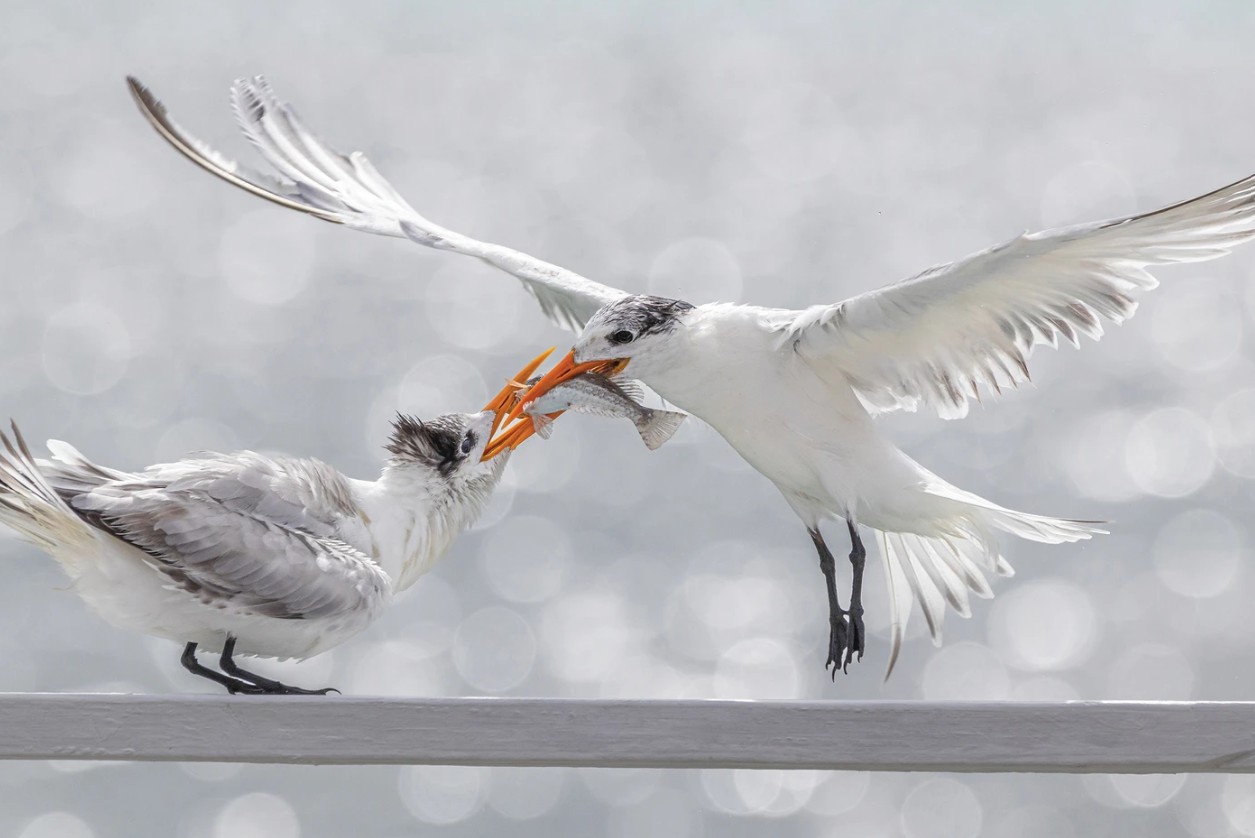
7. Birds Without Borders: Yoshiki Nakamura
Thousands of white geese fill the frame, their translucent yellow-white wings creating an abstract pattern. Their individual bodies are barely visible.
- Competition: United States and Canada
- Species: Snow Goose
- Photo location: Mount Vernon, Washington, USA
- Camera: Nikon D850 with Nikon AF-S 600mm f/4e lens and Nikon AF-S TC-17E-II teleconverter; 1/15 second at f/25; ISO 64
Migrating long distances between their Arctic nesting grounds and temperate wintering areas, snow geese are creatures of habit. A first-breeding female typically returns to the area near where she hatched, followed by a male she met further south; they mate for life and return to the same location each summer. Stopover and wintering sites are also very consistent, with young geese learning from their parents and large flocks returning to the same areas year after year.
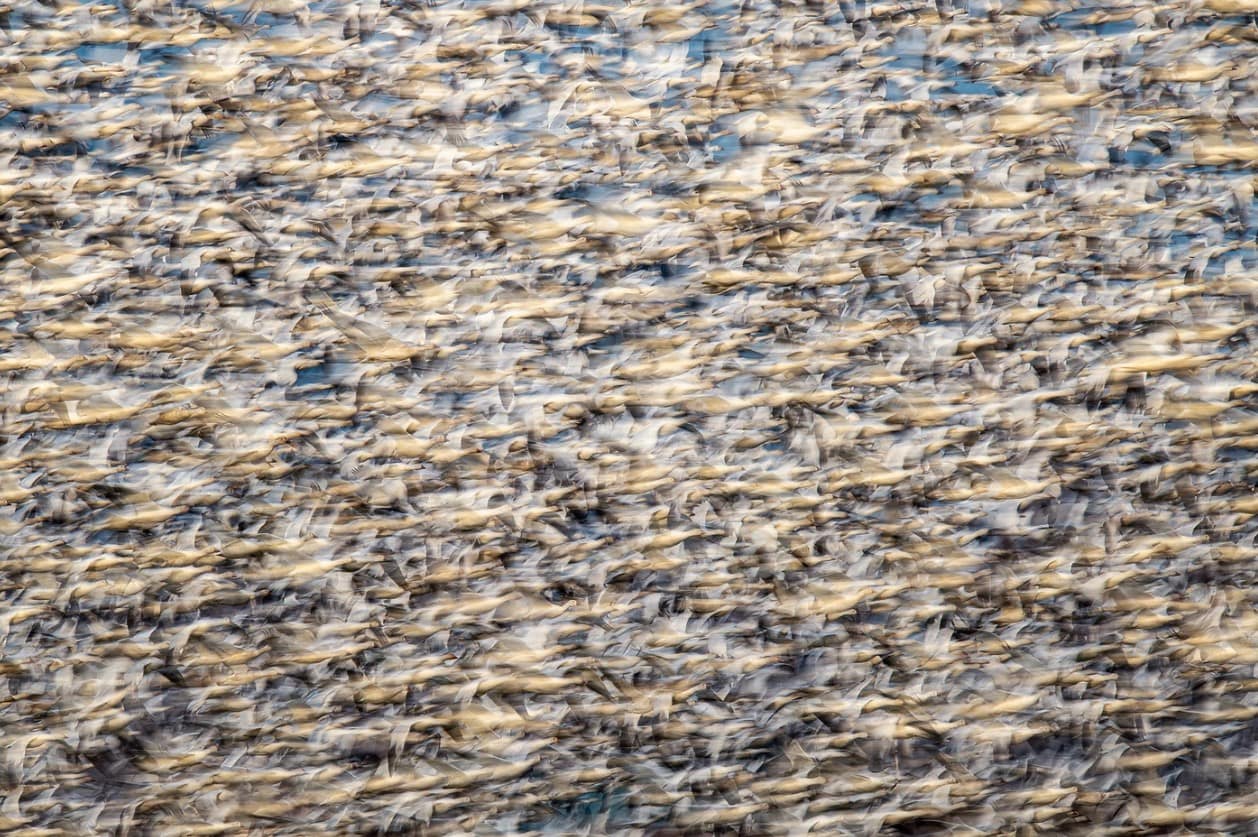
8. Conservation: Luis Alberto Peña
A dark brown hawk perched on a pile of dry grain. Behind the fire burned, but amidst the smoke and orange flames, the bird remained alert and calm.
- Competition: Chile and Colombia
- Species: Savanna Hawk
- Photo location: Cucuta, Norte de Santander, Colombia
- Camera: Nikon Coolpix P900 with fixed 24-2000mm f/2.8-6.5 lens at 152mm; 1/500 sec at f/5.6; ISO 200
Bird lore: Almost any change in habitat hurts some birds and benefits others. In tropical America, deforestation has decimated many species, but some lowland species have thrived and expanded their ranges. The aptly named Savanna Hawk is one of the beneficiaries, spreading into newly cleared grasslands and farmlands. These lanky raptors are usually solitary, but dozens of them may gather at grass fires, hunting rodents, snakes, and other creatures fleeing the flames.
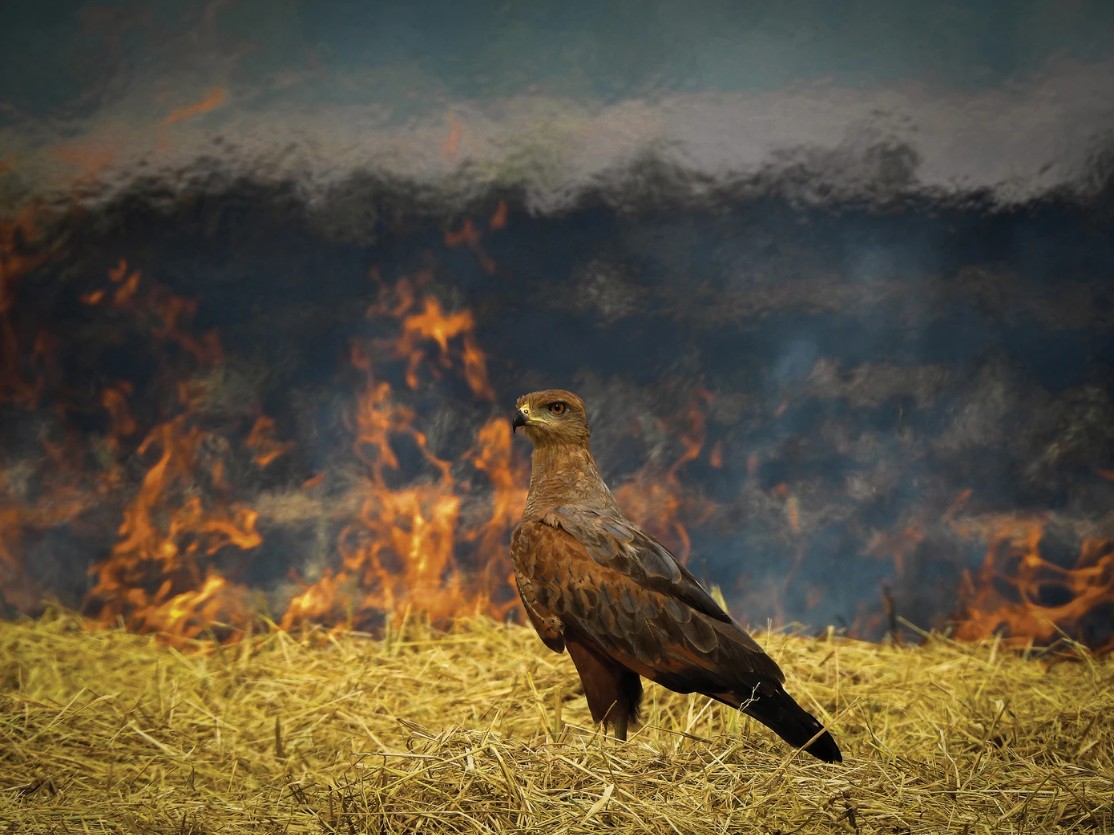
9. Conservation: Jean Hall
A pile of numbered wooden planks fills the frame, almost all of them slightly blurred. In the right third of the photo, a small, sharp owl looks into the viewfinder.
- Competition: United States and Canada
- Species: Burrowing Owl
- Photo location: Marco Island, Florida, USA
- Camera: Canon EOS 5D Mark IV with Canon EF 24-105mm f/4 L IS USM lens at 105mm; 1/1600 sec at f/5.6; ISO 1600
Bird lore: Burrowing owls require large areas of open land, preferably open fields, to build underground nesting burrows. Such terrain was once common in North America—both in the West (where prairie dog colonies created numerous burrows) and in Florida (where the owls often burrowed for themselves). However, the rise of agriculture and the extermination of prairie dogs has drastically reduced the owl population in the West. In Florida, the remaining open lands are being encroached upon by housing developments.
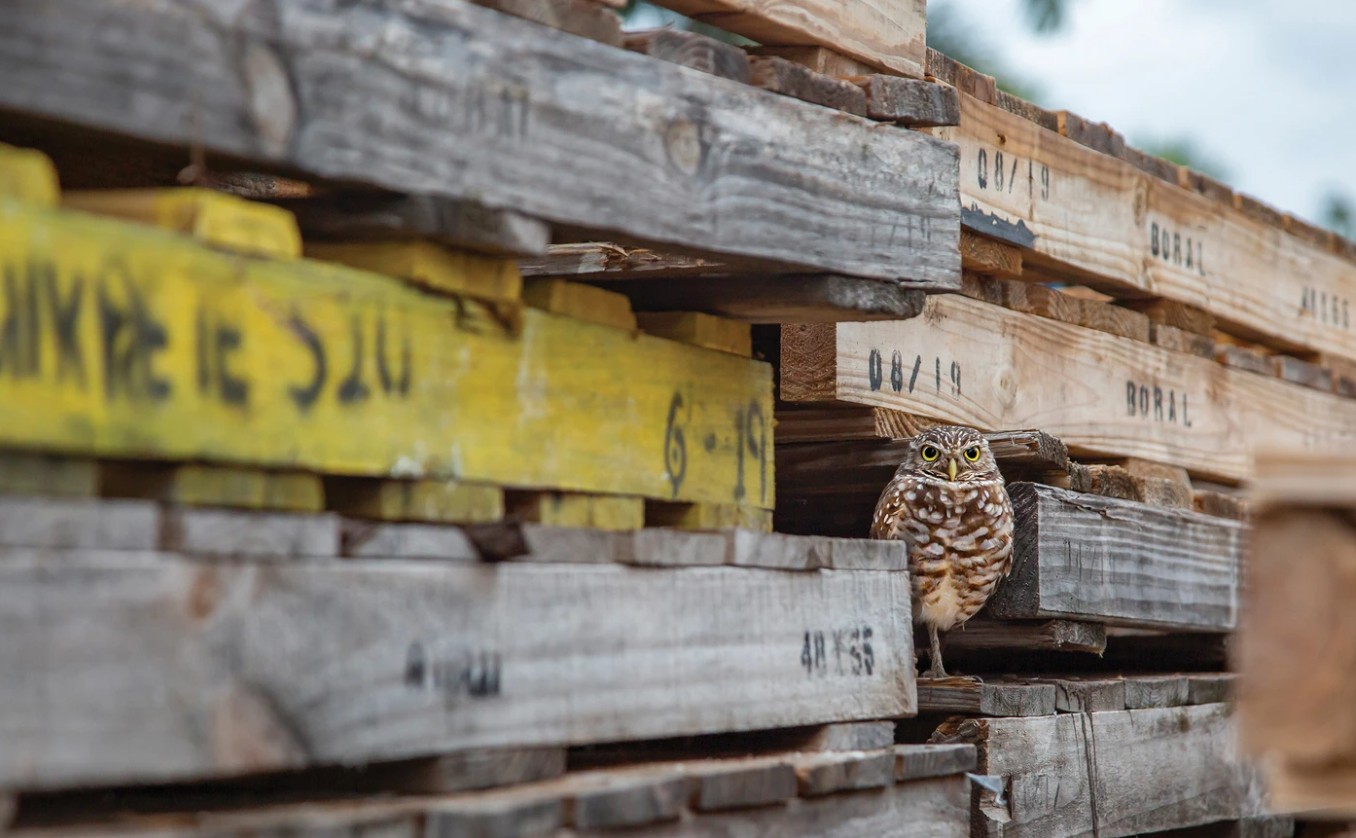
10. Plants for Birds: Barbara Swanson
A black cormorant in profile fills the frame. Its wings sweep forward, and its bright blue eye stands out. Its bill carries grassy material and a strand of pink bulbous algae.
- Competition: United States and Canada
- Species: Brandt's Cormorant
- Photo location: La Jolla, California, USA
- Camera: Nikon Z8 with Nikon NIKKOR Z 600mm f/6.3 VR S lens; 1/4000 sec at f/7.1; ISO 4000
We might not think of seabirds as relying on vegetation, but many cormorants use plant material to build sturdy nests on rocky outcrops. Along the Pacific coast, Brandt’s cormorants collect building materials from shallow water and adjacent land, including false eelgrass, yellow asters, sedges, grasses, seaweeds and algae, along with feathers and random debris. The male does most of the collecting, but both parents hand-arrange the nest.
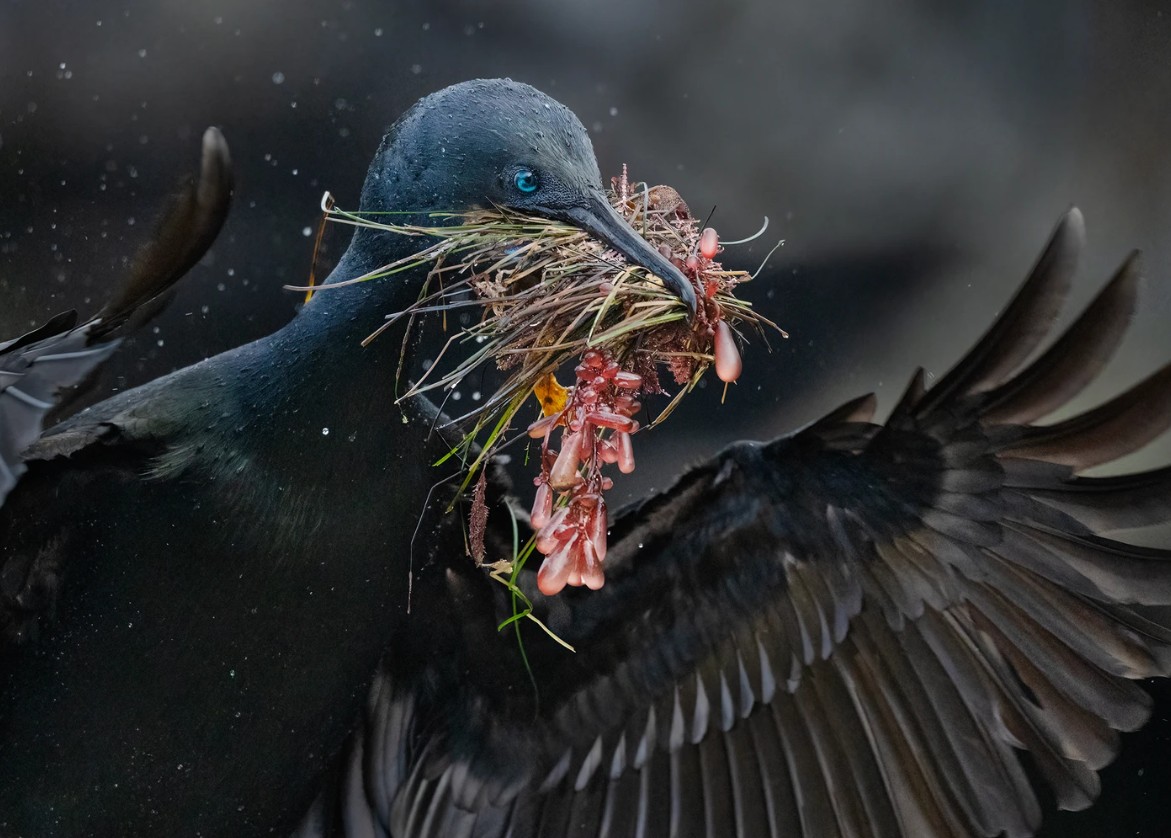
11. Tree for Birds, Colombia: Cristian Valencia
A hummingbird with brilliant plumage of electric purple, black, and yellow spots hovers in the center of the frame as it dips its long beak into a cluster of yellow flowers.
- Competition: Chile and Colombia
- Species: Purple-backed Thornbill
- Photo location: Villamaría, Caldas, Colombia
- Camera: Sony Alpha 7 II with Sigma 100-400mm f/5-6.3 DG DN OS Contemporary lens at 324mm; 1/1000 sec at f/6.3; ISO 2500
In tropical America, many hummingbird species can coexist because they differ in bill shape and feeding habits, which have evolved with native plants. For example, species with very long bills often perch on long, tubular flowers, while species with curved bills may specialize in feeding on curved flowers. The purple-backed thornbill hummingbird, with the shortest bill of any hummingbird, often clings to small flower clusters such as Gaiadendron punctatum , while probing individual flowers, sometimes extracting nectar by inserting its bill through slits at the base of the flower tube. It also eats small insects, catching them in mid-air or picking them from flowers.
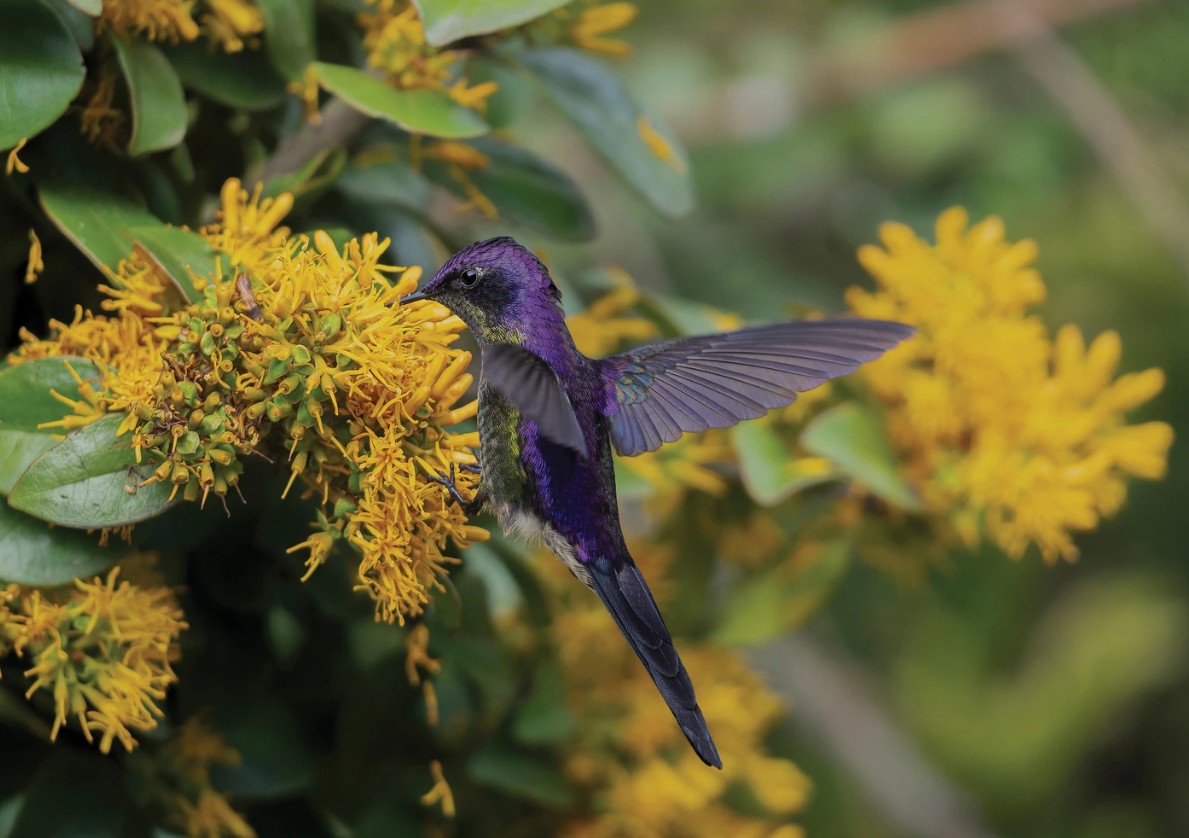
12. Tuổi trẻ: Camilo Sanabria Grajales
A small bird with a deep orange breast and black and white striped wings perched on a mossy branch, a moth clutched in its beak. The moth's tiny scales floated in the air.
- Competition: Chile and Colombia
- Species: Black warbler
- Photo location: Santiago de Cali, Valle del Cauca, Colombia
- Camera: Canon EOS Rebel T7 with Sigma 150-600mm f/5-6.3 DG OS HSM Contemporary lens at 468mm; 1/640 sec at f/6.3; ISO 800
Blackburnian warblers inhabit two very different worlds. They breed in eastern Canada and the northeastern United States, primarily in spruce or hemlock forests. But for the rest of the year, they are endemic to the Andes, breeding in cloud forests and subtropical forests at higher elevations. In much of the upper Andean forests, Blackburnian warblers are the most common migrant warbler, often joining mixed flocks with sparrows and other resident birds.
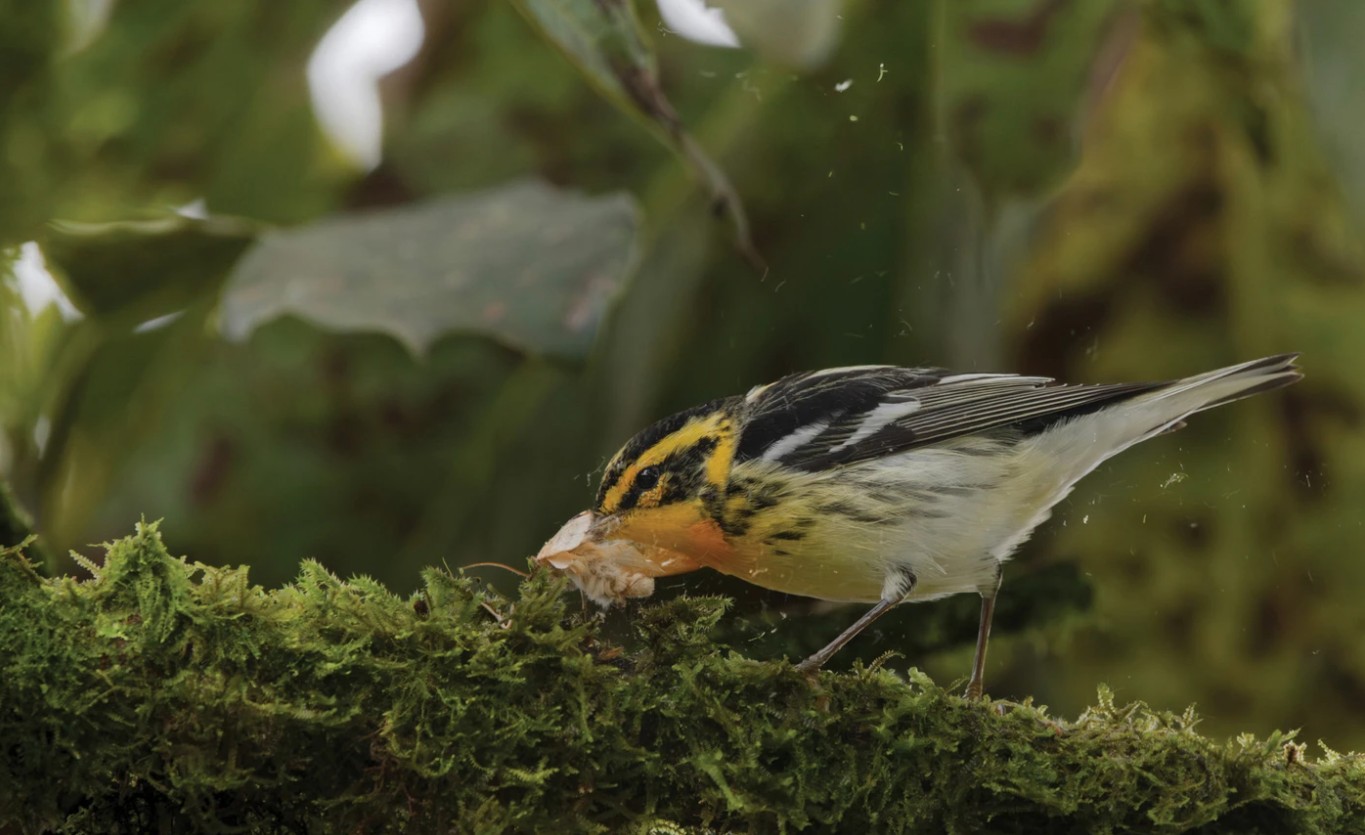
13. Youth: Parham Pourahmad
An owl with yellow eyes and wings spread behind its head flies above a marsh. The long grasses are hazy and the background is lit with shades of yellow and orange.
- Competition: United States and Canada
- Species: Long-eared owl
- Photo location: Fremont, California, USA
- Camera: Nikon D3500 with Sigma 150-600mm f/5-6.3 DG OS HSM Contemporary lens at 600mm; 1/1000 sec at f/6.3; ISO 1800
Long-eared owls and short-eared owls are named after the length of the tufts on their heads (which do not connect to the true ears). Long-eared owls are sometimes considered woodland birds because they roost in trees, while short-eared owls roost on the ground in marshes and fields. However, both species forage in open habitats, flying low to the ground, listening for rodents.
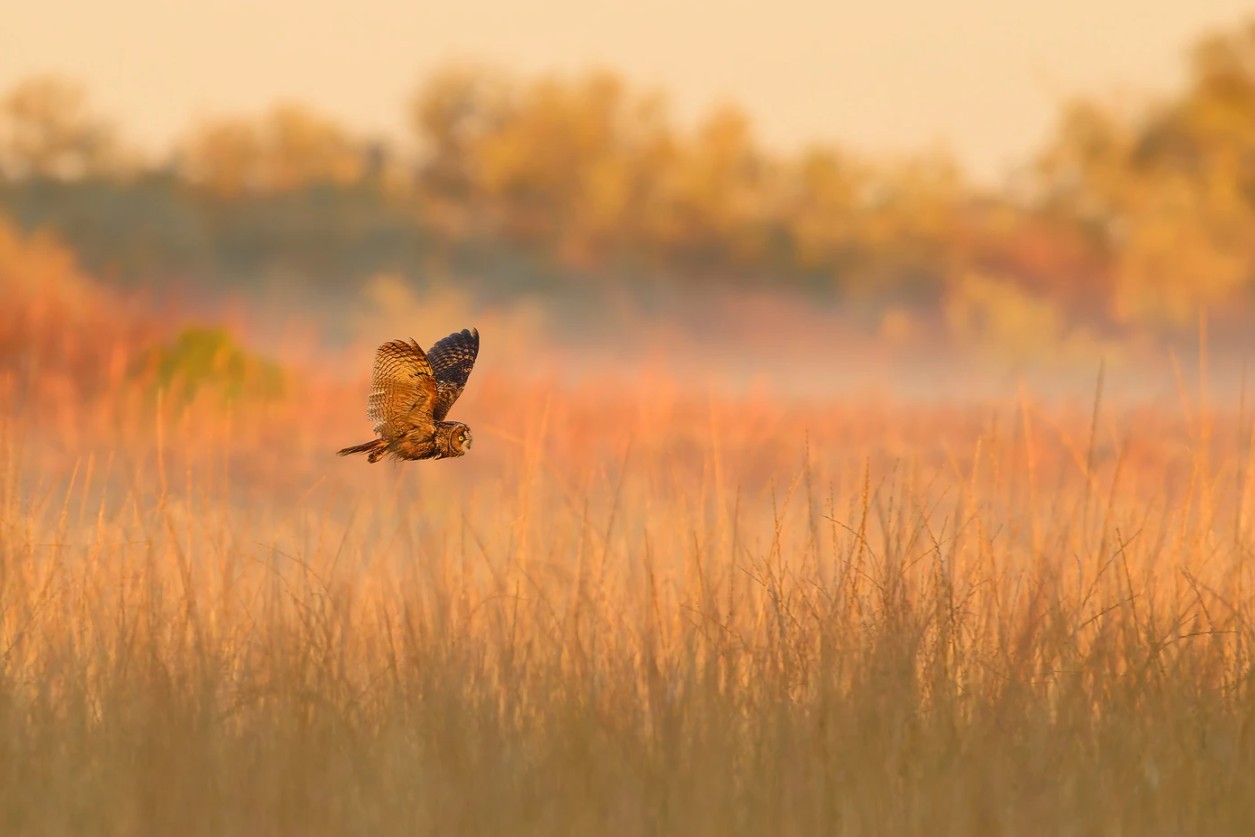
14. Coastal Birds, Chile: Francisco Castro Escobar
A black-and-white American oystercatcher feeds a baby mussel with its long orange bill. The scene is hazy, surrounded by rocks and sea.
- Competition: Chile and Colombia
- Species: American Shellfisher
- Photo location: Antofagasta, Antofagasta Province, Chile
- Camera: Sony Alpha 7 IV with Sony FE 200-600mm f/5.6-6.3 G OSS lens at 600mm; 1/640 sec at f/8; ISO 500
Oystercatchers are distinctive shorebirds, known for their large, colorful bills and specialized feeding habits. They prey on oysters, mussels, clams, and similar species, using a variety of techniques to extract the mollusks from their shells. Chicks take time to learn these techniques: while most shorebirds can forage for food on their own as soon as they hatch, oystercatcher parents continue to feed their young for several weeks while they gradually learn to forage for food on their own.
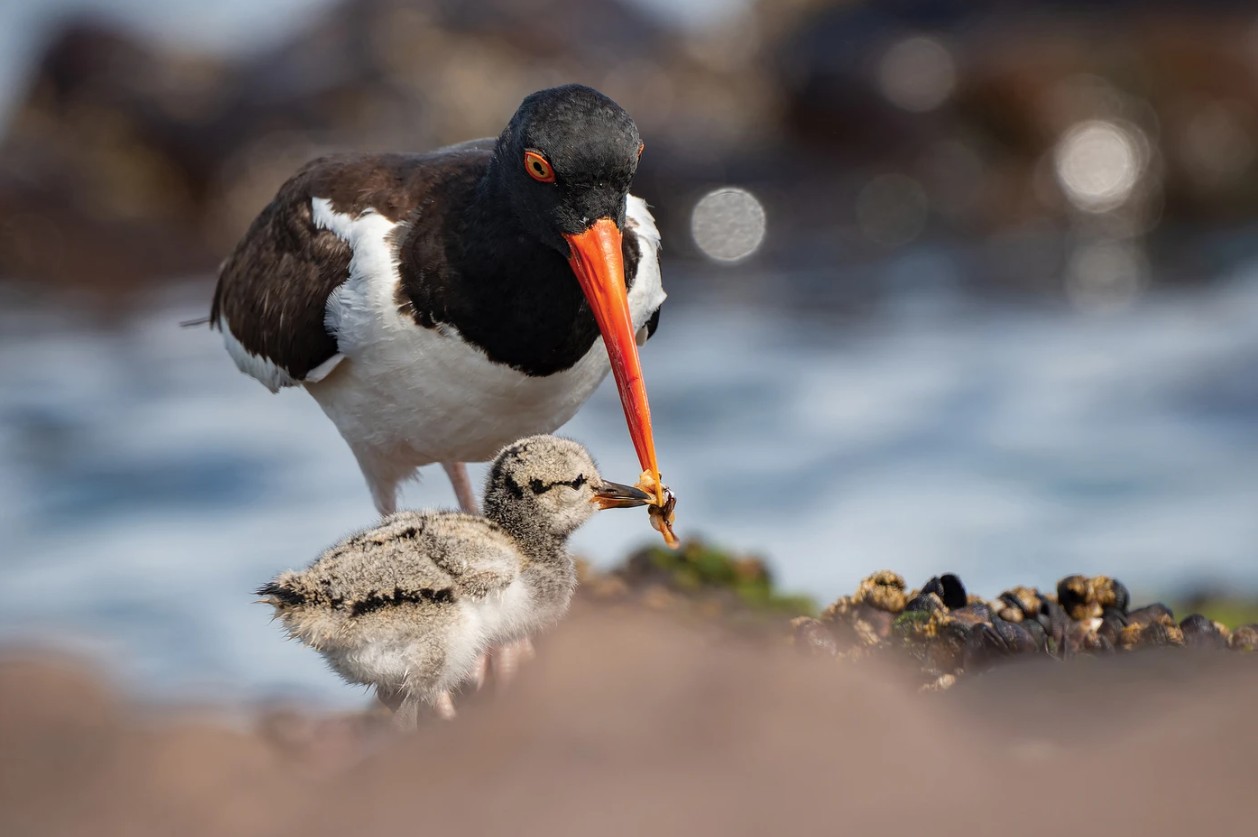
15. Female Award: Sean Pursley
A chestnut-capped sparrow perches on a branch covered in lush green lichen. The bird is facing the camera, its head tilted to one side and its bill feathered.
- Competition: United States and Canada
- Species: Chipping Sparrow
- Photo location: Bogus Basin, Idaho, USA
- Camera: Sony Alpha 1 with Sony 200-600mm f/5.6-6.3 G OSS lens at 840mm and Sony FE 1.4x teleconverter; 1/1000 sec at f/9; ISO 1250
One of our most common native songbirds, chipping sparrows can be found in summer from coast to coast, from central Alaska to Central America. As expected, with such a large range, they nest in a wide variety of habitats. In the Eastern states, they can be common in suburbs and city parks; further west, they often spend the summer in mountain forests. Pairs often stick together when selecting a nest site and starting to build, but the female does the actual building.
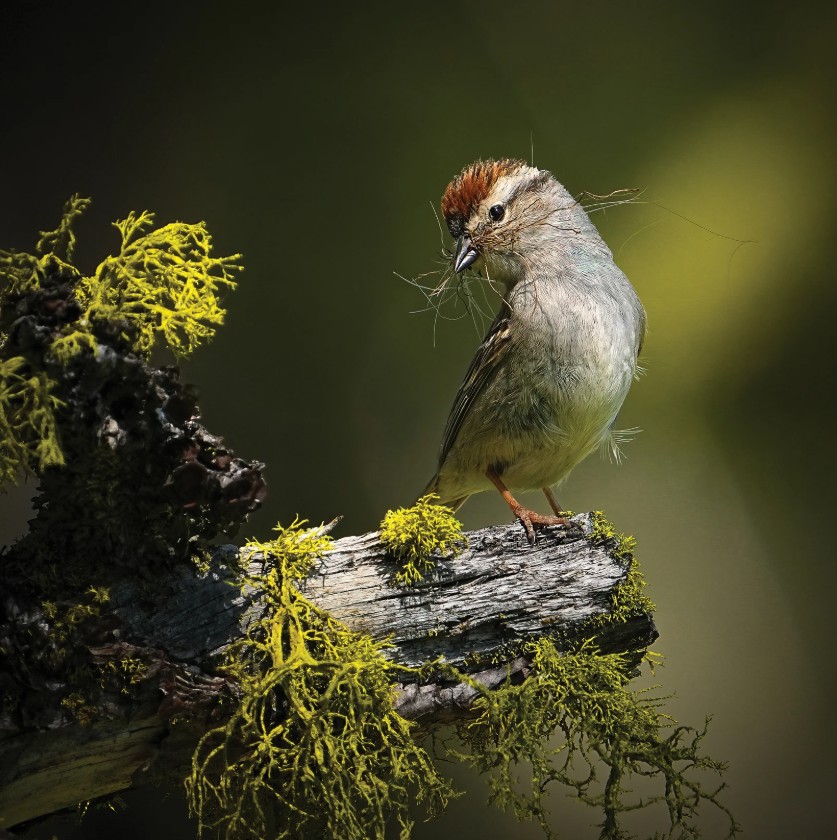
The 2025 Audubon Photography Awards are not only a celebration of outstanding photography, but also a powerful reminder of the relationship between humans and nature. Each photograph is not simply a work of art, but a story of survival, of the fragility of ecosystems, and of our responsibility to protect our habitats.









































